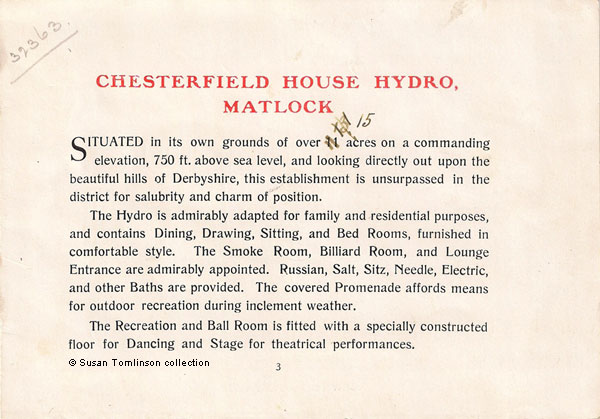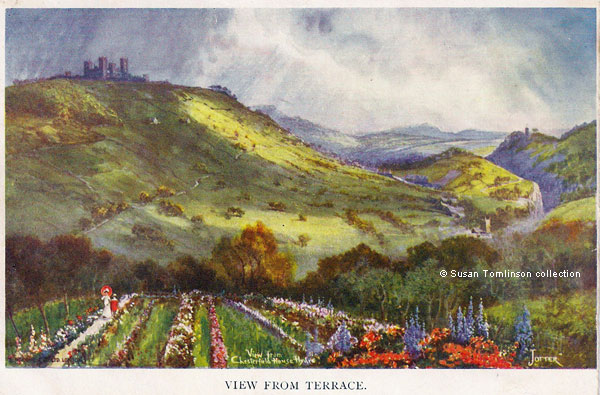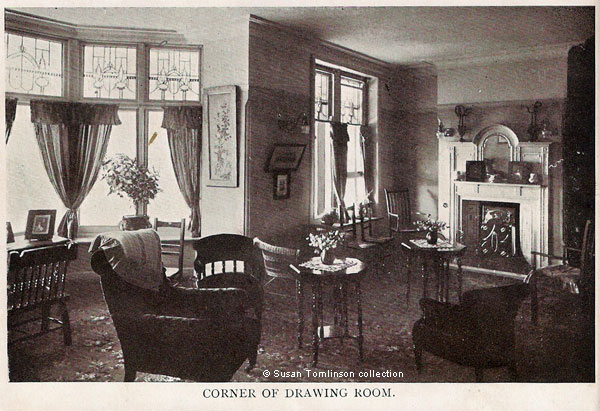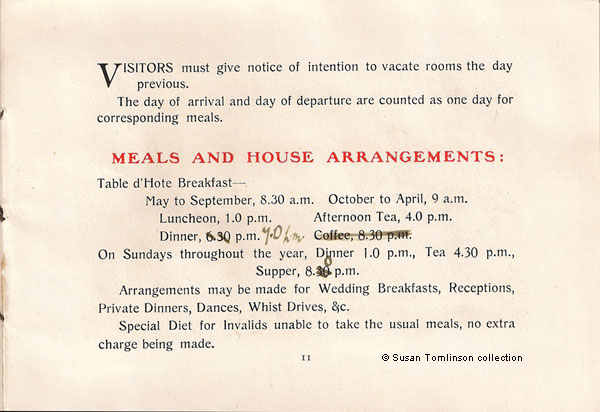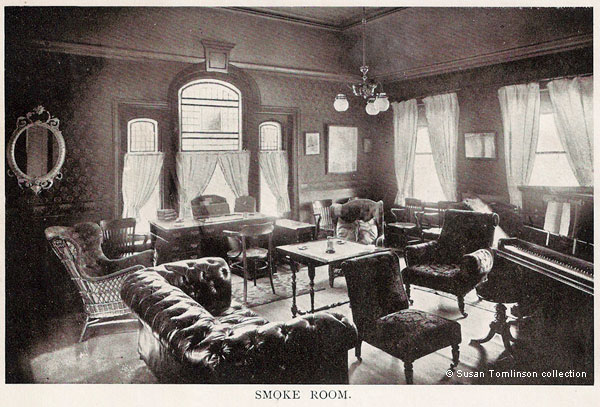|
Images Index> Matlock, 20th and 21stC Images> This page |
| Matlock: Chesterfield House Hydro Brochure, 1906-17 |
| Matlock : Twentieth Century Photographs, Postcards, Engravings & Etchings |
|
|||||||||||||||||
The pages are fastened together with either cotton or thin string and it was printed, and probably published, by A. Burkhart & Co. Ltd., London who also produced the View of the House and Grounds as a postcard (see the postcard on the previous page). The second coloured image in the brochure, shown below, is by the artist "Jotter" and shows a beautifully kept garden full of flowers and with magnificent views of High Tor and Riber. The photograph of the Recreation Room and Ballroom is particularly interesting as behind the sofa, where the grand piano is, was a stage for various theatrical performances and undoubtedly where the bands played at the hydro's balls. However, it is what is flanking the stage that is of real interest as we can see the two wonderful console tables that were later removed to Lilybank Hydro, probably by John Kay[3]. This image was reproduced in a later brochure for Chesterfield House, when the Presentation Convent Sisters had taken over and Chesterfield House had become a school.
Whilst the brochure originates from before the First World War, it is worth mentioning Mrs. Margaret Sutherns, an experienced business woman in the hotel trade, who took over Chesterfield House in 1917. She was born and grew up in Handsworth, marrying Frank (or Francis) Dunk in 1890 who had managed Ben Rhydding for many years[4]. Frank kept the Victoria Hotel in Station Street, one of the largest hotels in Nottingham, and the couple had a son - Henry Bishop Dunk[5]. Frank, from whom it was later said that she had inherited most of her fortune, unfortunately died in 1906[7] and later that year Margaret was at the Bentinck Hotel, also in Station Street[7]. She re-married in 1910, her second husband being Thomas Harold Sutherns who was quite a bit younger than her. The Sutherns were living at The Poultry Hotel in The Poultry (Nottingham) in 1911, when Margaret was shown as the hotel's proprietor whilst her husband was a Hotel Valuer[8]. Unfortunately, Margaret was widowed once more in 1913[9]. She was still the licensee of the Poultry Hotel in 1919[10], so was the running two establishments.
Margaret Sutherns married for the third time in 1920, this time
choosing as her husband a very young Matlock man, one Henry Edward
Smith who changed his surname by deed poll to Smith-Wilkinson when
they married[12].
He was also known as "Sunny" (or Sonny) Smith. He had once
been a dancing instructor at the Palais Dance in Derby, worked for
a time as the manager of Matlock Cinema and after his wife's death
as a
guide at Masson cavern. The couple seem to have led, in some
respects, a rather extravagant life but the marriage was not a happy
one and did not last. Margaret passed away on 2nd Dec 1924 at St
Thomas' Hospital in London after a long and painful illness[13].
She had sold her Nottingham bungalow and its contents just a couple
of months before, merely saying she would leave Nottingham with
many regrets[14]. Her
husband was not included in her Will and after her death he served
a writ on her representatives but the judge refused to try the case[15].
Mr. Smith-Wilkinson also spoke to the newspapers and there were claims
that his wife was "the best dressed woman in the world" and
that the wardrobes at Chesterfield House (plus, for a time, wardrobes
in the Ritz Hotel) were stuffed full of her clothes including something
like 3,000 dresses, some from Paris and the House of Worth. It seems
she did not buy the dresses to wear[13].
How much of what was written in the press was actually true is unknown
but her widower thought her estate was worth around twice what it
actually was. Nevertheless, if she earned her money, which she clearly
had, why should anyone be judgemental in how she chose to spend it?
Mr. Smith-Wilkinson remarried in 1935 and the following year he was
working as a postman in Kendal[16]. |
|||||||||||||||||
|
Brochure in the collection of and provided by and © Susan Tomlinson. Researched, written by and © Ann Andrews. Intended for personal use only. |
|||||||||||||||||
|
[1] During late 1906 and 1907 there were several advertisements stating that Chesterfield House was under new management. The first was published in the "Derbyshire Courier" of 2 October 1906. Another advert, printed in the "Derbyshire Times" of 19 December 1906 gives Mr. Hitching's name as the manager. [2] "Western Daily Press", 27 July 1942. Obituary for Arthur Hitching states "he came to Bristol in 1917". [3] The console tables were not at Chesterfield House when the Presentation Sisters too it over in 1927. [4] "Derbyshire Advertiser and Journal", 29 June 1918. The Switzerland of England. Attractions of the Matlocks. A mid-England Beauty spot. Chesterfield House Hydro. [5] 1891 Census and 1901 census. [7] He passed away at Mablethorpe on 10 Sep 1906. Later reports ("Lancashire Evening Post", 5 December 1924) said she claimed to have made her fortune from her own efforts of pen painting. [7] From an unspecified newspaper. [8] The 1911 census, available on FindMyPast. [9] He died 16 Dec 1913 at Skegness. [10] "Nottingham Evening Post", 19 August 1919. She was charged with selling stout above the maximum price, and also with failing to exhibit the price. [11] "Nottingham Evening Post", 16 May 1919 (announcement of death) and "Derbyshire Courier", 24 May 1919 (report of circumstances of death). [12] "Nottingham Evening Post", 13 February 1920. Smith-Wilkinson - Sutherns. On the 11th instant by licence at St. Giles', Matlock Henry Edward Smith-Wilkinson of Matlock to Margaret Sutherns of Chesterfield House Hydro. Margaret Sutherns maiden name had been Wilkinson. [13] "Nottingham Evening Post", 8 December 1924. In loving memory Margaret Smith-Wilkinson, who died in London on December 2nd 1324, and was interred in the family vault at the Church Cemetery. "The Scotsman" of 4 December 1924 provided a balanced view of her later life, claiming that she often visited the poorer parts of London in the evening, distributing cake and fruit to the children sitting on the kerbs. She had also stayed in a suite at the Ritz Hotel for a time. As for the dresses, "The Scotsman" claimed she bought so many dresses to provide employment for the people who made them. The story had appeared in the "Leeds Mercury" a few days before on 4 December 1924 and a similar sympathetic story was printed in the "Lancashire Evening Post", 5 December 1924. [14] "Westminster Gazette", 26 September 1924. The property was apparently full of people, not only looking for a bargain but also buying up smaller items of china etc as a memento. [15] "Nottingham Evening Post", 3 July 1926. [16] GRO indexes and the 1939 Register
which is available on FindMyPast. |






